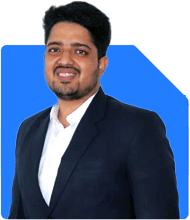Ramalingam Kalirajan |10906 Answers |Ask -Follow
Mutual Funds, Financial Planning Expert - Answered on May 14, 2024
He has an MBA in finance from the University of Madras and is a certified financial planner.
He is the director and chief financial planner at Holistic Investment, a Chennai-based firm that offers financial planning and wealth management advice.... more

I am 34 years old. I started investing in a SIP of 250000 per month from Nov 2023. Will be investing for 15 years to create a corpus of 30cr at 21% XIRR I am investing in 11 funds equally Hdfc mid cap Quant mid cap Motilal oswal mid cap Tata nifty midcap 150 momentum 50 index fund Quant small cap Sbi nifty small cap 250 index Hdfc large and mid cap Icici large and mid cap Quant flexi cap Parag parikh flexi cap Sbi energy opportunities fund Please suggest If I should consider any changes.
1. Large Investment, Great Potential!
Disciplined Approach! Investing such a significant amount consistently shows discipline. This is a key factor for wealth creation.
Diversified Portfolio: Your portfolio has a mix of Mid Cap, Small Cap, Large & Mid Cap, Flexi Cap, and a Sectoral Fund (Energy). Actively managed funds like these have fund managers who try to outperform the market by picking stocks they believe will grow.
Sectoral funds focus on specific industries, amplifying the risk associated with economic fluctuations and sector-specific challenges. Their narrow investment mandate exposes investors to higher volatility and concentration risk.
Additionally, sectoral funds lack diversification, making them vulnerable to adverse market conditions within the targeted sector. Timing the entry and exit points becomes crucial due to the cyclical nature of industries, increasing the complexity of investment decisions.
Overall, while sectoral funds offer potential for higher returns during sector upswings, they entail heightened risk and may not suit investors seeking broad-based diversification and stability in their portfolios.
Direct funds lack personalized advice and ongoing support, requiring investors to navigate the complexities of the market independently. They may lead to suboptimal investment decisions due to the absence of professional guidance.
In contrast, regular funds, accessed through a Mutual Fund Distributor (MFD) with Certified Financial Planner (CFP) support, offer tailored advice aligned with individual financial goals. MFDs provide valuable insights, portfolio rebalancing, and assistance during market fluctuations, enhancing investor confidence and decision-making.
Regular funds also often provide additional services such as goal planning, tax optimization, and periodic reviews, ensuring a holistic approach to wealth management.
2. Reaching Your Target:
Ambitious Goal! Targeting a Rs. 30 crore corpus in 15 years with a 21% XIRR (internal rate of return) is highly ambitious. Historically, Equity has delivered good returns, but there are no guarantees.
Market Performance Matters! Market fluctuations can significantly impact your final corpus. A 21% XIRR might be difficult to achieve consistently over 15 years.
3. Let's Analyze Your Portfolio:
Multiple Mid Cap Funds: Having three Mid Cap Funds might lead to overlapping holdings. Consider merging some for better diversification.
Actively Managed vs. Index Funds: While actively managed funds have the potential for higher returns, they also come with higher fees. A small allocation to an Index Fund could provide broader market exposure.
4. Seek Professional Guidance:
Role of a CFP: A Certified Financial Planner (CFP) can analyze your risk tolerance, investment goals, and assess your portfolio.
Personalized Strategy: A CFP can recommend an optimized portfolio allocation that balances risk and reward to potentially maximize your returns and reach your goals.
Remember, reaching your financial goals requires a well-defined strategy, discipline, and realistic expectations of market returns. Consulting a CFP can help you create a personalized plan and increase your chances of success.
Here's the key takeaway: You've made a fantastic start! Consider consulting a CFP to fine-tune your portfolio and potentially reach your long-term goals.
Best Regards,
K. Ramalingam, MBA, CFP,
Chief Financial Planner,
www.holisticinvestment.in
You may like to see similar questions and answers below
Nikunj Saraf | Answer |Ask -Follow
Mutual Funds Expert - Answered on Mar 29, 2023
Ramalingam Kalirajan |10906 Answers |Ask -Follow
Mutual Funds, Financial Planning Expert - Answered on Apr 23, 2024
Ramalingam Kalirajan |10906 Answers |Ask -Follow
Mutual Funds, Financial Planning Expert - Answered on May 14, 2024
Ramalingam Kalirajan |10906 Answers |Ask -Follow
Mutual Funds, Financial Planning Expert - Answered on May 25, 2024
Ramalingam Kalirajan |10906 Answers |Ask -Follow
Mutual Funds, Financial Planning Expert - Answered on Nov 01, 2024
Ramalingam Kalirajan |10906 Answers |Ask -Follow
Mutual Funds, Financial Planning Expert - Answered on Dec 19, 2025
Nayagam P P |10859 Answers |Ask -Follow
Career Counsellor - Answered on Dec 19, 2025
Ramalingam Kalirajan |10906 Answers |Ask -Follow
Mutual Funds, Financial Planning Expert - Answered on Dec 19, 2025
Ramalingam Kalirajan |10906 Answers |Ask -Follow
Mutual Funds, Financial Planning Expert - Answered on Dec 19, 2025
Ramalingam Kalirajan |10906 Answers |Ask -Follow
Mutual Funds, Financial Planning Expert - Answered on Dec 19, 2025
Radheshyam Zanwar |6751 Answers |Ask -Follow
MHT-CET, IIT-JEE, NEET-UG Expert - Answered on Dec 19, 2025
Radheshyam Zanwar |6751 Answers |Ask -Follow
MHT-CET, IIT-JEE, NEET-UG Expert - Answered on Dec 19, 2025
Samraat Jadhav |2514 Answers |Ask -Follow
Stock Market Expert - Answered on Dec 18, 2025
Reetika Sharma |432 Answers |Ask -Follow
Financial Planner, MF and Insurance Expert - Answered on Dec 18, 2025
Reetika Sharma |432 Answers |Ask -Follow
Financial Planner, MF and Insurance Expert - Answered on Dec 18, 2025























